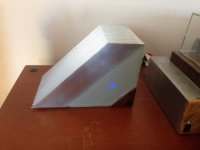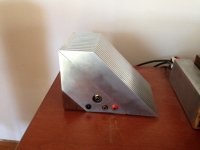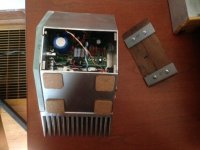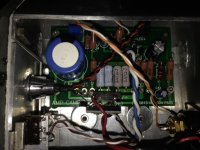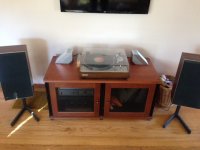No
AAARGH, so pretty !
translation from Dutchlish to ZMengrish :
Fugly!

Cinco, very nice form. It's elegant!
Thanks. Have you ever noticed how the heat sink always determines the shape of the chassis? These were a couple I had that would do the job. I was inspired by a Zen amp on the Pass DIY with big butcher block sides and huge heat sinks.
I forgot to mention it uses IRFP040 that I happened to find, about to be scrapped from the power supply lab at my old job.

Cinco
Cinco, very nice form. It's elegant!
+1
design path: amps take shape
Drjbf1, I too think its smart to be able to take apart an amp without de-soldering. It's crazy to have to de-solder to work on an amp! What I do now when I build is put RCAs on a sub-pannel that unscrews. It does call for a bit of fussy cutting, drill and tap work and some care wth the wires and such but it makes good sense and keeps connections to the minimum.
Cinco, yes, heat management is most of the problem that defines an amps shape, that and then wire path. Its no wonder amp cases tend to look one way. The next logical step is to cease with running cables front to back at all and keep everything on one side, the business side! Stuff would end up looking like a new kind of steampunk switchboard but that could be cool too!
Drjbf1, I too think its smart to be able to take apart an amp without de-soldering. It's crazy to have to de-solder to work on an amp! What I do now when I build is put RCAs on a sub-pannel that unscrews. It does call for a bit of fussy cutting, drill and tap work and some care wth the wires and such but it makes good sense and keeps connections to the minimum.
Cinco, yes, heat management is most of the problem that defines an amps shape, that and then wire path. Its no wonder amp cases tend to look one way. The next logical step is to cease with running cables front to back at all and keep everything on one side, the business side! Stuff would end up looking like a new kind of steampunk switchboard but that could be cool too!
Here's my first Zen amp (and probably not the last one  ). I used the classic Zen topology with a few changes:
). I used the classic Zen topology with a few changes:
1. 2SK1058 used as Q1 and IRFP9240 as Q2;
2. Different Q1 biasing circuit. I put 4k7 trimmer pot between Q1 drain and GND and connected the Q1 gate to the slider via 68k resistor; also removed Z1 because Q1 has it inside;
3. R1 increased to .44ohm (2x.22ohm/5W in series) so the quiescent current of each channel is about 1.5A;
4. Increased C1/C2 to 100 000uF total (no additional filtering).
5. Made my own PCB layout and connected the ground directly to Q1 sources (with these thick ugly black cables ). It helped (along with increasing supply caps) to decrease mains hum significantly; it became virtually inaudible, unless I stick my ear very close to the speaker (less than 1ft).
). It helped (along with increasing supply caps) to decrease mains hum significantly; it became virtually inaudible, unless I stick my ear very close to the speaker (less than 1ft).
The total cost of making this amp was less than $100. It sounds great, even with not-so-perfect speakers. This thing made me think about giving up making tube amps for good . It runs pretty hot, but it doesn't hurt to touch the heatsinks or tranny after ~1h of use.
. It runs pretty hot, but it doesn't hurt to touch the heatsinks or tranny after ~1h of use.
1. 2SK1058 used as Q1 and IRFP9240 as Q2;
2. Different Q1 biasing circuit. I put 4k7 trimmer pot between Q1 drain and GND and connected the Q1 gate to the slider via 68k resistor; also removed Z1 because Q1 has it inside;
3. R1 increased to .44ohm (2x.22ohm/5W in series) so the quiescent current of each channel is about 1.5A;
4. Increased C1/C2 to 100 000uF total (no additional filtering).
5. Made my own PCB layout and connected the ground directly to Q1 sources (with these thick ugly black cables
The total cost of making this amp was less than $100. It sounds great, even with not-so-perfect speakers. This thing made me think about giving up making tube amps for good
An externally hosted image should be here but it was not working when we last tested it.
An externally hosted image should be here but it was not working when we last tested it.
An externally hosted image should be here but it was not working when we last tested it.
ACA Monoblocks
Amp Camp Amp monoblocks. Electronically just the basic ACA boards with the addition of a latching on/off switch circuit activated by pressing the glass tile on the front. Build thread can be viewed here
Amp Camp Amp monoblocks. Electronically just the basic ACA boards with the addition of a latching on/off switch circuit activated by pressing the glass tile on the front. Build thread can be viewed here
Attachments
Amp Camp Amp monoblocks. Electronically just the basic ACA boards with the addition of a latching on/off switch circuit activated by pressing the glass tile on the front. Build thread can be viewed here
That ART DIY Amplifier
Excellent ! Congratulations !
Just one thing your amp boxes have some air flow
or is closed all around the circuits ?
Last edited:
There are vent holes drilled along the bottom and top edges of the sinks. Theoretically, convective flow draws cooler air through the bottom and spit out hot air at the top. In practice, I've run these amps for hours on warm days without any ill effects. I do realize that the lifespan of some components may be shortened, but I'll cross that bridge when I get there.
There are vent holes drilled along the bottom and top edges of the sinks. Theoretically, convective flow draws cooler air through the bottom and spit out hot air at the top. In practice, I've run these amps for hours on warm days without any ill effects. I do realize that the lifespan of some components may be shortened, but I'll cross that bridge when I get there.
Yeah so is not one beauty amplifier but safe as well.
Very cool design i like it very much. Thanks
My Zen HeadAmp.
Thanks to Papa Nelson and Tortello.
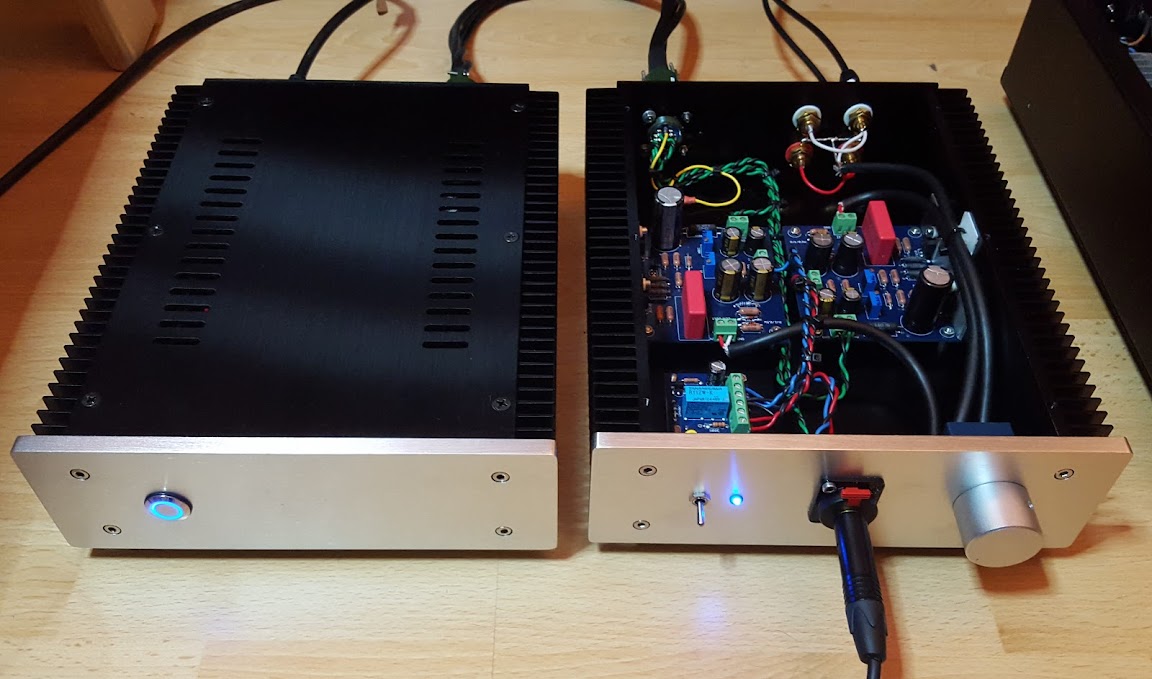
Very nice.
Are you using shunt regulators in the power supply?
Very nice build.Thanks!!
I use a single rain psu without regulators. It's a simple desing buenas I need add two extra caps.

- Home
- Amplifiers
- Pass Labs
- Pictures of your diy Pass amplifier
